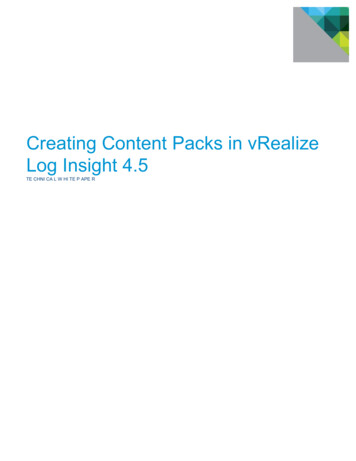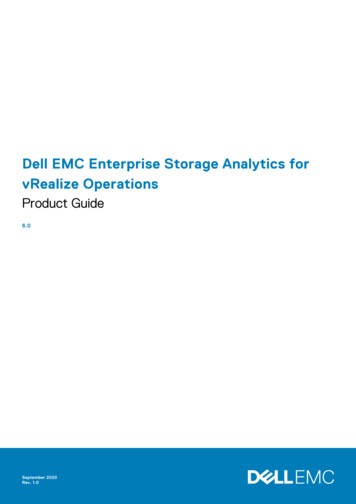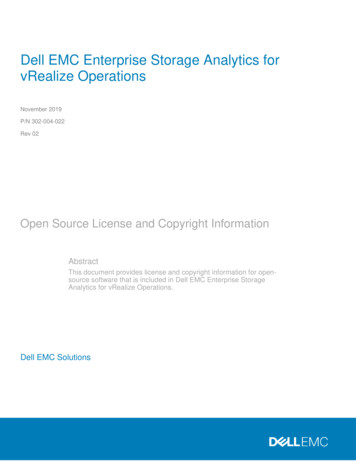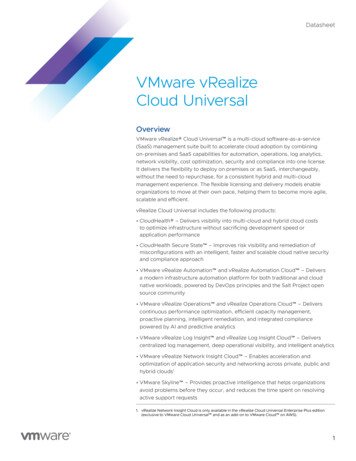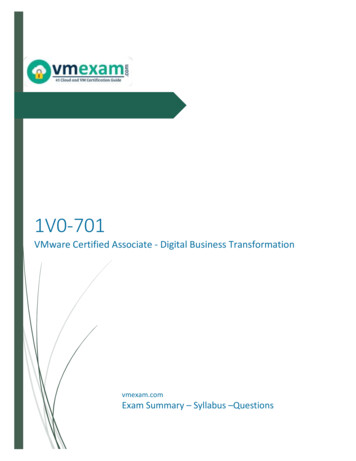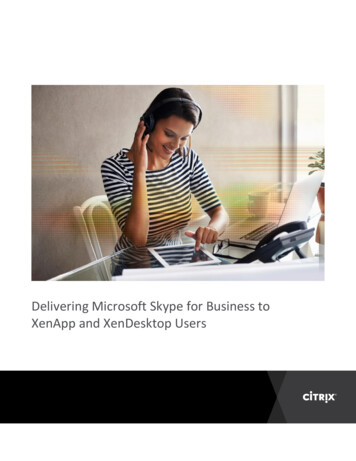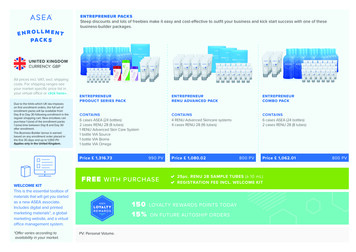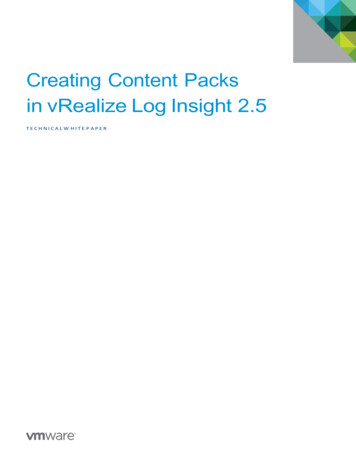
Transcription
Creating Content Packsin vRealize Log Insight 2.5TECHNICAL W HITE P APER
Creating Content Packs invRealize Log Insight 2.5Table of ContentsIntroduction . . . . . . . . . . . . . . . . . . . . . . . . . . . . . . . . . . . . . . . . . . . . . . . . . . . . . . . . . . . . . . . . . . 4Intended Audience . . . . . . . . . . . . . . . . . . . . . . . . . . . . . . . . . . . . . . . . . . . . . . . . . . . . . . . . . . . . 4Getting Started . . . . . . . . . . . . . . . . . . . . . . . . . . . . . . . . . . . . . . . . . . . . . . . . . . . . . . . . . . . . . . . 4Instance . . . . . . . . . . . . . . . . . . . . . . . . . . . . . . . . . . . . . . . . . . . . . . . . . . . . . . . . . . . . . . . . . . . . . .4User . . . . . . . . . . . . . . . . . . . . . . . . . . . . . . . . . . . . . . . . . . . . . . . . . . . . . . . . . . . . . . . . . . . . . . . . .4Events . . . . . . . . . . . . . . . . . . . . . . . . . . . . . . . . . . . . . . . . . . . . . . . . . . . . . . . . . . . . . . . . . . . . . . . .4Authors . . . . . . . . . . . . . . . . . . . . . . . . . . . . . . . . . . . . . . . . . . . . . . . . . . . . . . . . . . . . . . . . . . . . . . . 5Queries . . . . . . . . . . . . . . . . . . . . . . . . . . . . . . . . . . . . . . . . . . . . . . . . . . . . . . . . . . . . . . . . . . . . . . 5Saving Queries . . . . . . . . . . . . . . . . . . . . . . . . . . . . . . . . . . . . . . . . . . . . . . . . . . . . . . . . . . . . . . . . 5Message Queries . . . . . . . . . . . . . . . . . . . . . . . . . . . . . . . . . . . . . . . . . . . . . . . . . . . . . . . . . . . . . .6Field Queries . . . . . . . . . . . . . . . . . . . . . . . . . . . . . . . . . . . . . . . . . . . . . . . . . . . . . . . . . . . . . . . . . 7Orphaned Fields . . . . . . . . . . . . . . . . . . . . . . . . . . . . . . . . . . . . . . . . . . . . . . . . . . . . . . . . .8Aggregation Queries . . . . . . . . . . . . . . . . . . . . . . . . . . . . . . . . . . . . . . . . . . . . . . . . . . . . . . . . . . .9Bar Charts . . . . . . . . . . . . . . . . . . . . . . . . . . . . . . . . . . . . . . . . . . . . . . . . . . . . . . . . . . . . . . .9Line Charts . . . . . . . . . . . . . . . . . . . . . . . . . . . . . . . . . . . . . . . . . . . . . . . . . . . . . . . . . . . . 10Stacked Charts . . . . . . . . . . . . . . . . . . . . . . . . . . . . . . . . . . . . . . . . . . . . . . . . . . . . . . . . .10Multi-Colored Charts . . . . . . . . . . . . . . . . . . . . . . . . . . . . . . . . . . . . . . . . . . . . . . . . . . . 12Message Queries . . . . . . . . . . . . . . . . . . . . . . . . . . . . . . . . . . . . . . . . . . . . . . . . . . . . . . . .13Alerts . . . . . . . . . . . . . . . . . . . . . . . . . . . . . . . . . . . . . . . . . . . . . . . . . . . . . . . . . . . . . . . . . . . . . . .13Thresholds . . . . . . . . . . . . . . . . . . . . . . . . . . . . . . . . . . . . . . . . . . . . . . . . . . . . . . . . . . . . . .13Dashboards . . . . . . . . . . . . . . . . . . . . . . . . . . . . . . . . . . . . . . . . . . . . . . . . . . . . . . . . . . . . . . . . . . 14Dashboard Groups . . . . . . . . . . . . . . . . . . . . . . . . . . . . . . . . . . . . . . . . . . . . . . . . . . . . . . . . . . .14Dashboard Widgets . . . . . . . . . . . . . . . . . . . . . . . . . . . . . . . . . . . . . . . . . . . . . . . . . . . . . . . . . .15Chart . . . . . . . . . . . . . . . . . . . . . . . . . . . . . . . . . . . . . . . . . . . . . . . . . . . . . . . . . . . . . . . . . .15Query . . . . . . . . . . . . . . . . . . . . . . . . . . . . . . . . . . . . . . . . . . . . . . . . . . . . . . . . . . . . . . . . . .16Widgets . . . . . . . . . . . . . . . . . . . . . . . . . . . . . . . . . . . . . . . . . . . . . . . . . . . . . . . . . . . . . . . . 17Content Packs . . . . . . . . . . . . . . . . . . . . . . . . . . . . . . . . . . . . . . . . . . . . . . . . . . . . . . . . . . . . . . . 19View . . . . . . . . . . . . . . . . . . . . . . . . . . . . . . . . . . . . . . . . . . . . . . . . . . . . . . . . . . . . . . . . . . . . . . . 19Export . . . . . . . . . . . . . . . . . . . . . . . . . . . . . . . . . . . . . . . . . . . . . . . . . . . . . . . . . . . . . . . . . . . . . 20Private . . . . . . . . . . . . . . . . . . . . . . . . . . . . . . . . . . . . . . . . . . . . . . . . . . . . . . . . . . . . . . . . 20Public . . . . . . . . . . . . . . . . . . . . . . . . . . . . . . . . . . . . . . . . . . . . . . . . . . . . . . . . . . . . . . . . . 20Import . . . . . . . . . . . . . . . . . . . . . . . . . . . . . . . . . . . . . . . . . . . . . . . . . . . . . . . . . . . . . . . . . . . . . .21Edit. . . . . . . . . . . . . . . . . . . . . . . . . . . . . . . . . . . . . . . . . . . . . . . . . . . . . . . . . . . . . . . . . . . . . . . .21Publish . . . . . . . . . . . . . . . . . . . . . . . . . . . . . . . . . . . . . . . . . . . . . . . . . . . . . . . . . . . . . . . . . . . . . .21TECHNICAL W HITE P APER / 2
Creating Content Packs invRealize Log Insight 2.5Conclusions . . . . . . . . . . . . . . . . . . . . . . . . . . . . . . . . . . . . . . . . . . . . . . . . . . . . . . . . . . . . . . . . . 22Getting Started . . . . . . . . . . . . . . . . . . . . . . . . . . . . . . . . . . . . . . . . . . . . . . . . . . . . . . . . . . . . . .22Instance . . . . . . . . . . . . . . . . . . . . . . . . . . . . . . . . . . . . . . . . . . . . . . . . . . . . . . . . . . . . . . . .22User . . . . . . . . . . . . . . . . . . . . . . . . . . . . . . . . . . . . . . . . . . . . . . . . . . . . . . . . . . . . . . . . . . .22Queries . . . . . . . . . . . . . . . . . . . . . . . . . . . . . . . . . . . . . . . . . . . . . . . . . . . . . . . . . . . . . . . . . . . . . .22Message Queries . . . . . . . . . . . . . . . . . . . . . . . . . . . . . . . . . . . . . . . . . . . . . . . . . . . . . . . .22Field Extraction . . . . . . . . . . . . . . . . . . . . . . . . . . . . . . . . . . . . . . . . . . . . . . . . . . . . . . . . .22Aggregation Queries . . . . . . . . . . . . . . . . . . . . . . . . . . . . . . . . . . . . . . . . . . . . . . . . . . . .22Alerts Queries . . . . . . . . . . . . . . . . . . . . . . . . . . . . . . . . . . . . . . . . . . . . . . . . . . . . . . . . . .22Dashboards . . . . . . . . . . . . . . . . . . . . . . . . . . . . . . . . . . . . . . . . . . . . . . . . . . . . . . . . . . . . . . . . . .23Dashboard Groups . . . . . . . . . . . . . . . . . . . . . . . . . . . . . . . . . . . . . . . . . . . . . . . . . . . . . .23Dashboard Widgets . . . . . . . . . . . . . . . . . . . . . . . . . . . . . . . . . . . . . . . . . . . . . . . . . . . . .23Content Packs . . . . . . . . . . . . . . . . . . . . . . . . . . . . . . . . . . . . . . . . . . . . . . . . . . . . . . . . . . . . . . .23Resources . . . . . . . . . . . . . . . . . . . . . . . . . . . . . . . . . . . . . . . . . . . . . . . . . . . . . . . . . . . . . . . . . . . 23Acknowledgments . . . . . . . . . . . . . . . . . . . . . . . . . . . . . . . . . . . . . . . . . . . . . . . . . . . . . . . . . . . . 23About the Author . . . . . . . . . . . . . . . . . . . . . . . . . . . . . . . . . . . . . . . . . . . . . . . . . . . . . . . . . . . . 24TECHNICAL W HITE P APER / 3
Creating Content Packs invRealize Log Insight 2.5IntroductionContent packs are read-only plug-ins to vRealize Log Insight that provide pre-defined knowledgeabout specific types of events such as log messages. The purpose of a content pack is to provideknowledge about a specific set of events in a format that is easily understandable by administrators,engineers, monitoring teams, and executives. A content pack should answer questions like, “Is theproduct/application healthy?” In addition, a content pack should create a greater understanding of how aproduct/application works.A content pack comprises information that can be saved from either the Dashboards or Interactive Analyticspages in Log Insight. This includes: Queries Fields Aggregations Alerts DashboardsBy default, the current version of Log Insight ships with the vSphere and General content pack. Other contentpacks can be imported as required. In addition, any Log Insight user can create a content pack for private or publicconsumption.Intended AudienceThis paper provides information about each piece of information that can be saved in a content pack, as well asbest practices for content pack creation. The information provided is specifically tailored to content pack authorsusing Log Insight 2.5.Getting StartedBefore creating a content pack, it is important to understand some concepts regarding the content packworkflow. The tips in this section will make creating and maintaining content packs easier.InstanceContent packs are read-only plug-ins to Log Insight, which means imported content packs, cannot beedited. The easiest way to edit a content pack is to modify the saved definitions on the instance of LogInsight that was used to initially create the content pack. The original instance should be backed up toprevent data loss or corruption. If the instance used to create the content pack is lost and no backup exists,the content pack must be recreated on a new instance. Although certain components of a content pack canbe cloned into a custom dashboard, also known as user space, doing so is not a recommended way to edita content pack and might result in a content pack that is dependent on a separate content pack.Alternatively, you can import a content pack into My Content (user space) and edit the content pack.However, if you have other widgets (dashboards, alerts, extracted fields and queries) from before you dothe import, ensure you save and remove them before you import to avoid mixing of original content withthe imported content.UserContent packs are created in part from the content saved under Custom Dashboards, or more specificallyeither My Dashboards or Shared Dashboards on the Dashboards page. When exporting a content pack,everything within the selected custom dashboard is exported. For this reason, it is recommended that everyindividual content pack be authored by a separate user entity in Log Insight. For information on creatingusers in Log Insight, please refer to the Log Insight in-product documentation.TECHNICAL W HITE P APER / 4
Creating Content Packs invRealize Log Insight 2.5EventsIt is essential to collect relevant events before attempting to create a content pack, to ensure that thecontent pack covers all relevant events for a product/application. A common way to collect relevant eventsis with the assistance of quality assurance (QA) and/or support teams, because these teams usually haveaccess to, and knowledge about, common events. Attempting to generate events while creating a contentpack is time consuming and will likely result in missing important events. If QA and support teams areunable to supply events, simulated events can be used instead, assuming that product/application eventsare known and/or documented.Once appropriate logs have been collected, they must be ingested into Log Insight. Although not supportedin the current version of Log Insight, it is possible to ingest events from the command line using the sameprocess as the archive import process described in the Log Insight Installation and Administration Guide. Inshort, any file, directory, tarball, or ZIP file can be ingested by copying the events to the Log Insight virtualappliance and ight repository import /path/to/events OR/usr/lib/loginsight/application/bin/loginsight repository import –f tag‐name value /path/to/events.Although this process is not supported, it does work and is recommended when creating a content pack.AuthorsThe authors of a content pack should possess the following competencies. Experience using VMware vRealize Log Insight. Real-world operating knowledge of the product/application. Understanding of and ability to generate optimized regular expressions. Experience with using logs to debug multiple problems with the product/application. Support background, with exposure to a variety of problems. System administrator background with previous syslog experience.QueriesLog Insight allows queries to retrieve and summarize events. Queries can be created and saved from theInteractive Analytics page. A query comprises one or more of the following: Keywords: Complete, or full-text, alphanumeric and/or hyphen matches. Globs: Asterisk and/or question mark symbols used to match some quantity of keywords. Regular expressions: Sophisticated string pattern matching, based on Java regular expressions. Field operations: Keyword, regular expression, and pattern matches applied to extracted fields. Aggregations: Functions that are applied to one or more subgroups of the results. Log Insightsupports the following types of queries: Message: A query formed of keywords, regular expressions and/or field operations. Regular expression or field: A query formed of keywords and/or regular expressions. Aggregation: A query formed of a function, one or more groupings, and any number of fields. Customalerts can be defined in Log Insight and are triggered from scheduled queries of any type.Saving QueriesQueries can be saved using one or more of the following methods: Add to Dashboard: Saves the last-run query without time range as a chart, query in a query list, orfield table widget in a dashboard group on the Dashboards page. Save Current Query: Saves the last-run query with a time-specific time range as a loadable query onthe Interactive Analytics page. Queries that are saved using Save Current Query that are exportedas part of a content pack do not include any time range.Figure 1. Note the Add to Dashboard link just below the navigationbar on the Interactive Analytics page.Figure 2.The Save Current Query link under the menu drop-downon the Interactive Analytics page.TECHNICAL W HITE P APER / 5
Creating Content Packs invRealize Log Insight 2.5The notes section is very important and should be populated for every query. Information can be added astext, a link to documentation, a knowledge base article, or a forum. Information provided shouldanswer the following questions: Why is this widget important? What is a “good” and a “bad” value? Where can more information be obtained?Figure 3.Add to Dashboard dialog box with notes section.Figure 4.Save Current Query dialog box with notes section.Message QueriesMessage queries can be entered using one or more of the following methods: Search bar: The search bar is one way to refine the results that are returned, given the existing events ina Log Insight instance. Although a constraint can be used instead of the search bar, it is often easier tounderstand a query that leverages the search bar over an equivalent constraint. As such, best practice isto use the search bar whenever possible, instead of an equivalent constraint. Constraints: A constraint allows querying using a regular expression, a field, logical OR and ANDoperations, or a combination of search bar and constraint queries.Figure 5. An example of the search bar with a keyword and aconstraint with an equivalent query.Using the search bar ispreferential.Figure 6. An example of the search bar with a keyword, a constraint with aregular expression, and a constraint with a field operation. In order for thequery to return a result, all three items need to return a match.Although query building is beyond the scope of this document, there are several important things to knowabout the search bar and constraints when creating content packs. In general, the following best practicesapply: When constructing a query, use keywords whenever possible. When keywords are not sufficient, use globsand when globs are not sufficient, use regular expressions. Keyword queries are the least resource-intensivequery type. Globs are a simplified version of regular expression and are the next least resource-intensivetype of query. Regular expressions are the most resource-intensive query type and adversely affect queryperformance. Avoid regular expressions whenever possible. If a query can be written without regular expressions, itshould be. This is primarily because, from a resource perspective, regular expressions are the mostintensive query type. Leverage globs instead of regular expressions when keywords are notsufficient.TECHNICAL W HITE P APER / 6
Creating Content Packs invRealize Log Insight 2.5 Provide as many keywords as possible. When using regular expressions or fields, be sure to include as manykeywords as possible. Keywords should be outside any regular expressions, including a logical OR such as(this that). Regular expressions use a lot of resources. Keyword queries are the least resource-intensivequery type and Log Insight is optimized to implement keyword queries before regular expressions, tominimize regular expression overhead.Figure 7.An example of two different ways to construct the samequery. The first constraint is a regular expression. The second is akeyword, comma separated, logical OR match. The secondconstraint is always preferred over the first.Figure 8 . An example of two different ways to query for the same field. Thefirst constraint is generic and contains only two keywords. The secondconstraint is specific and has five keywords. The second constraint isalways preferred over the first.Field QueriesFields are a powerful way to add structure to unstructured events and allow for the manipulation of boththe textual and visual representation of data. Fields are one of the most important items in a content packbecause they can be used in multiple ways including: Aggregations: Allowing for functions and groupings to be applied to fields. Constraints: Allowing for operations to be performed against fields.Any part of a log message that might be applicable to a query or aggregation should be extracted. Fields area type of regular expression query and are especially useful for complex pattern matching, so a user doesnot need to know, remember, or learn complicated regular expressions. Regex before value: This field should include as many keywords as possible. If the field is empty or onlycontains special characters, the Regex after value must include keywords. Regex after value: This field should include as manykeywords as possible. If this field is empty or onlycontains special characters, the Regex before valuemust include keywords. Name: Only use alphanumeric characters. Ensurethat all characters are lower case and useunderscores instead of spaces as this makes fieldseasier to view. Important: Names for content packfields and user fields can be the same, althoughcontent pack fields will have a namespace inparenthesis to the right of the field name. It isrecommended to prefix content pack fields with anabbreviaton (e.g. vmw ) to avoid confusion.Figure 9 . An example of an extracted fielddefinition with multiple keywords . Additional context: From vRealize Log Insight 2.5 onwards you can also add keywords to a field calledAdditional context (keyword search terms,) to further refine your search and improve query performance. Additional context: From vRealize Log Insight 2.5 onwards you can also add a filter on a static field asadditional context (filter) with an operator and value, to further refine your search and improve queryperformance.TECHNICAL W HITE P APER / 7
Creating Content Packs invRealize Log Insight 2.5In addition to the various components that comprise a field, several best practices must be considered. These include: Only create fields for regular expression patterns. If a field can bequeried using keyword queries, use keyword queries instead ofa pre-defined field. Fields are intended to add structure tounstructured data and to provide a way to query specific partsof an event. Figure 10 . The recommended way to query for keyword matches. Information enteredinto the search bar or a constraint can also be saved for future usage by clicking themenu drop-down next to the Search button and selecting Save Current Query. Only create fields for regular expression patterns that returna fraction of the total events. Fields that match most eventsand/or return a very large number of results are not a goodcandidate for field extraction because the regular expressionwill need to be applied to a large volume of events,resulting in a resource-intensive operation.Figure 11.An example of a keyword field.Since this query can be constructed withouta regular expression, it is not a goodcandidate for field extraction.Orphaned FieldsIt is common for queries to contain one or more fields. For saved queries, it is important to note that thefield definition used when a query is saved is always maintained. This means that, if a query is saved with afield and that field is later modified, the query will be modified when you update the field definition. In fact,if the field is used in other widgets such as dashboard chart or alert queries, those queries are alsoupdated. Field modifications include: The value of the field is changed. The regex before value and/or the regex after value of the field is changed. The name of the field is changed. The additional context of the field is changed. The field is deleted.TECHNICAL W HITE P APER / 8
Creating Content Packs invRealize Log Insight 2.5gFigure 12 . An example of running a query with an orphaned field . Noticethat the overview chart is grouped by security host and the security hostfield definition is open under the Fields section . This means the field doesnot exist in the Log Insight instance, but does exist as part of a chart widgetor saved query .Figure 13 . An example of what happens when an orphaned dialog box isclosed . Notice how the search bar remains the same, but the overview chartis no longer grouped by security host . In addition, security host is not listedunder the Fields section.TECHNICAL W HITE P APER / 9
Creating Content Packs invRealize Log Insight 2.5It is critical for saved queries that leverage a field to be recreated if the field is modified. If a previouslysaved query is not updated when a field it relies on is deleted, the saved query will contain an orphanedfield. An orphaned field is a field that exists in a saved query, but does not exist as an available field.Orphaned fields are visible when running a saved query in the Interactive Analytics page, because thenamespace (Temporary) appears next to the field name in the Fields section. Important: Saving, deleting,or modifying the field results in any use of the orphaned field being removed from the query.Ensure that content pack queries do not contain orphaned fields. If an orphaned field is found, recreatethe saved query and delete the old saved query to remove the orphaned field. To remove an orphanedfield from a chart widget:1. Go to the widget on the Dashboards page.2. Select the Edit in Interactive Analytics gear button within the widget.3. Modify the field(s) used.4. Select the Save followed by Return to Dashboard button on the Interactive Analytics page.Aggregation QueriesLog Insight allows visual manipulation of events through the use of aggregation queries. An aggregationquery is made up of two district attributes: Functions GroupingsIn content packs, groupings are the most important consideration, but both functions and groupings willbe addressed as they impact how charts are displayed. An aggregation query requires one function and atleast one grouping.Bar ChartsBy default, the Interactive Analytics page of Log Insight displays a count of events over time in theoverview chart. If the count function is used in conjunction with the time series grouping, a bar chart iscreated.Figure 14. An example of a bar chart using count of events over time.T E C H N I C A L W H I T E P A P E R / 10
Creating Content Packs invRealize Log Insight 2.5If the count function is used in conjunction with a single field grouping instead of time series, a bar chart iscreated with quantities listed from greatest to least.Figure 15 . An example of a bar chart using count of events grouped by a field .Line ChartsAll functions, except the count function, are mathematical and require a field against which to apply theequation. When performing a mathematical function on a field and grouping by time series, a line chart iscreated.Figure 16. An example of a line chart using average of a field over time.Stacked ChartsBy default, the overview chart on the Interactive Analytics page of Log Insight is a count of events overtime. If one field is added to the time series grouping, a stacked chart is created.Figure 17. An example of a stacked bar chart using count of events over time with a field.T E C H N I C A L W H I T E P A P E R / 10
Creating Content Packs invRealize Log Insight 2.5If grouping by time series, and a field and any function other than count is used, a stacked line chart is created.Figure 18 . An example of a stacked line chart using average of a field over time grouped by a field .Stacked charts are powerful when attempting to find anomalies for an object. Consideration needs to begiven to the number of objects that could be returned. In general, the following best practices apply: If the number of objects per bar returned will be less than ten, stacked charts are encouraged.Figure 19.An example of a stacked line chart with a small number of objects.The chart is easy to read and understand. If the number of objects returned per bar is or could be 10-20, stacked charts are good, but considerationmust be taken when visually representing the chart in a content pack. If the number of objects returned per bar is or could be greater than 20, stacked charts are discouraged.Figure 20.An example of a stacked bar chart with a large number of objects. The chart is hard to read and understand.The recommendations above are made because a greater number of objects means more resources arenecessary to parse and display information. In addition, distinguishing between objects can becomechallenging when a large number of objects are returned.T E C H N I C A L W H I T E P A P E R / 11
Creating Content Packs invRealize Log Insight 2.5Multi-Colored ChartsIf a grouping is created using more than one field and time series, a multi-colored chart is created. Thechart consists of two colors that interchange. Each interchange represents a new time range. Multi-coloredcharts can be hard to interpret so consider the value of such a chart before including it in a content pack.Figure 21.An example of a multi-colored bar chart using count of events over time, grouped by two fields.When grouping by multiple fields, consider removing the time series for a more easily understood bar chart.Figure 22 . An example of a multi-field grouping bar chart using count of events, grouped by two fields .If multiple fields are important over a time range, multiple charts could be created for each field individuallyover the time range. The charts could then be displayed in the same column of a dashboard group in acontent pack.Figure 23.An example of two similar charts stacked.Notice how one red alarm in blue matches mostly pink sources.T E C H N I C A L W H I T E P A P E R / 12
Creating Content Packs invRealize Log Insight 2.5Other ChartsSeveral other chart types are available, including pie and bubble charts. To use these charts, a specific querytype is required. If the option for these charts is available, you already have the correct query. If the optionfor these charts is not available, hover over the chart name you want to use. A pop-up message describesthe type of query required for the chart type.Message QueriesWhen constructing an aggregation query, the message query should only return results that are relevant tothe aggregation query. This makes analyzing easier and ensures only relevant fields are shown.Figure 24.An example of an aggregation query without a message query.This is not recommended.Figure 25.An example of an aggregation query with a message query.This is recommended. Notice the addition of filters for fields in theaggregation query with exists operator.AlertsAlerts provide a way to trigger a reaction when a certain type of event is seen. By default, Log Insightsupports two different types of alerts: Email vRealize Operations ManagerAlerts can only be saved in user space and as such, all content pack alerts are disabled by default. If anenabled alert is created and then exported as part of a content pack, the alert is disabled in the contentpack. This means that email and/or vRealize Operations Manager settings are not contained and cannot beadded to a content pack.ThresholdsIt is important to understand how thresholds work to ensure that, if enabled, a content pack alert does notunintentionally spam a user. When considering a threshold, there are two things to keep in mind: How frequently to trigger the alert: Log Insight comes with pre-defined trigger frequencies.Important: Alerts only trigger once for a specific threshold window. How often to check if an alert state has occurred: An alert is triggered by a query. Alerts, like queries, arenot real-time in the current version. For each threshold window, a pre-determined query frequency isbeen allocated. Changing the threshold changes the query time.T E C H N I C A L W H I T E P A P E R / 13
Creating Content Packs invRealize Log Insight 2.5Figure 26.An example of an alert.The threshold has been set to trigger when a type of vCenter Server event for a hostname is seen in the last hour. Thequery runs every 10 minutes and if the alert triggers, it will not run again for one hour.T E C H N I C A L W H I T E P A P E R / 14
Creating Content Packs invRealize Log Insight 2.5DashboardsDashboard GroupsA content pack comprises one or more dashboard pages known as dashboard groups.Figure 27.The vSphere content pack
Creating Content Packs in vRealize Log Insight 2.5 T E C H N I C A L W H I T E P A P E R. Creating ContentPacksin vRealize Log Insight 2.5 T E C H N I C A L W HITE P APER / 2 Table of Contents . vRealize Log Insight 2.5 T E C H N I C A L W HITE P APER / 3 .
